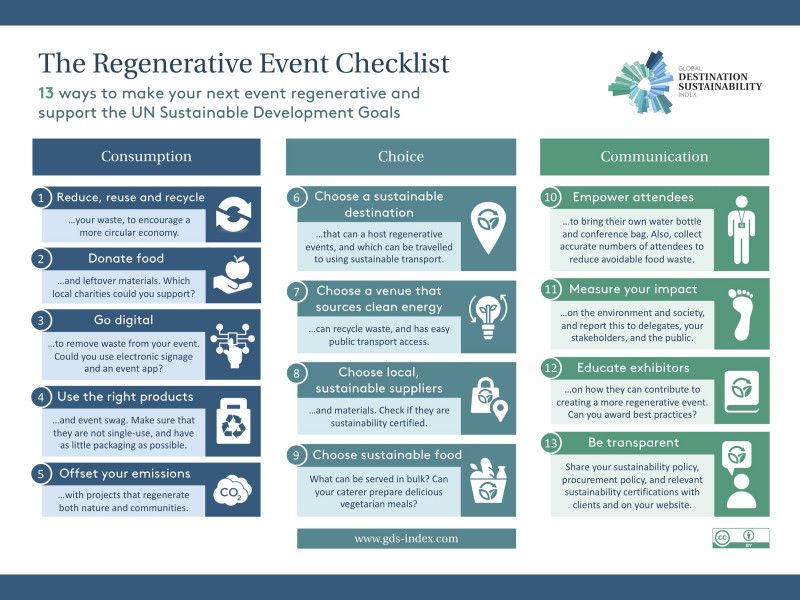You can download the Regenerative Event Checklist here.
As lockdown measures begin to loosen in Europe, life is slowly starting to resemble a more familiar past. However, there are notable differences, with the visitor economy and meetings industry, particularly hard hit. As we set out to recover from the impacts of covid-19, leaders are calling for a green and fair recovery to avoid a return to the ‘old normal’. It follows, that the meetings industry in particular will experience a tough rebound, unless both the economic importance of the industry, and a clear vision and plan for a more sustainable and regenerative way of organising events is defined.
The infographic shared through this article pertains to the latter. Namely, it outlines the different ways in which event organisers should be aligning their events with the broader agenda of sustainability. This will involve reimagining past practices, in order to achieve not only a green and fair recovery in the present, but a more regenerative industry for the future.
Each of the three areas of focus – Consumption, Choice, and Communication – are closely interlinked and overlap. For the sake of this article, four actions will be elaborated on through an interpretation of their relevance in a world ravaged by crises.
Choose local, sustainable suppliers:
Never before has the fragility of our global trade networks become as clear as during this pandemic. This has prompted a focus on sourcing event supplies through local and sustainable businesses. For event organisers, the first step will be to define what is ‘local’ in the tender evaluation process, and then identify the sustainability criteria that you require from these local suppliers. A balance between how local, and how sustainable they are will have to be made.
The environmental benefits of choosing local can result in energy and water conservation, and improved waste management. Aside of the direct economic benefits to a destination, choosing local suppliers helps create and safeguard jobs, enhances their business opportunities through exposure gained through the event, and can results in knowledge transfers that enhance the capacity and capabilities of the supplier. In the social dimension, the decision to go local, can give an event a stronger social license to operate, which in turn can improve brand value. Finally, local suppliers often have better knowledge of where the resources used for an event could be repurposed, and can thus be crucial in helping organisers to create a regenerative impact.
Measure your Impact:
When going virtual, when choosing local and sustainable suppliers, and when running any IRL event, the environmental, social, and economic impact that said event has in a destination (and beyond), is crucial to measure and communicate. Now, more than ever, will the event industry need to justify its existence, in order to uphold their social license to operate, and ensure funding and support from governments. For measuring social impact, our partners at #Meet4Impact have created a solid methodology, which involves defining your intention, stakeholders, and objectives; managing risk, responsibility, and action amongst your stakeholders; measuring a set of pre-determined indicators using the right metrics; and maximising the impact using storytelling and reporting. We won’t go into more detail here, so please visit their site if you are interested.
Of course, not all events will be able to adopt such a comprehensive approach to measuring their impact. For those that cannot, this does not mean not measuring their impact at all. Be it the waste produced per participant, the number of people helped through food donations, or the economic benefit of an event to a destination, we need to start measuring and communicating on our impact holistically, using the resources available to us.
Go Digital:
In the past months some of the largest events and tradeshows of the industry have been cancelled, and only very few have managed to create virtual alternatives. This has highlighted that, although virtual and hybrid events have existed for decades (the first prototypes popped up back in 1993), the quality of the tools available, and the skills of event managers and professional congress organisers to use them, is lacking. When going virtual with an event there exist gradations of digitisation, meaning that the degree to which we digitise an event can and should vary. To begin, we can turn different elements of an IRL (in real life) event digital, to avoid the unnecessary printing of conference badges or schedules. By using an event app, one can reduce the material waste, and create a more direct avenue for communicating with attendees, for example to share schedule changes.
We can create hybrid events, which by sharing certain sessions through livestreams will allow those people that could not attend due to personal obligations, resource limitations, or travel restrictions, to participate. The environmental impact of the event can thus also be reduced, as people fly less. Turning this into the default for organising events with international attendees should be the goal.
Going fully virtual with an event can present us with great challenges, but also great opportunities. The planning involved takes as long, or longer if unfamiliar to the organiser, than an IRL event. Technical issues that can arise also pose a threat to running these events smoothly. However, going virtual can be an economically and environmentally effective decision for many events, and allow for thousands of attendees from around the world to participate from the comforts of their own home. The post-covid era is likely to see stringent regulations limiting the types of human contact allowed, and further, the environmental impact of events will increasingly come into the spotlight as climate breakdown is upon us. Event organisers should ask themselves: which events and meetings are crucial to run IRL, and which can go virtual.
Reduce, Reuse, and Recycle:
Hygiene, single-use plastics, and waste, have grown closely related through the current health crisis. When it comes to organising events, creating a safe environment for people to meet in is paramount. Will this mean that any notion of creating a circular economy will have to be thrown out the window? Will single-use plastics become the go-to for organising events safely? With low oil prices impeding the economic viability of recycling, and the plastics industry utilising the current crisis to solidify its relevance in, and hold on, the global market, it certainly looks dysmal for the eco-warriors amongst us.
One key assumption that has to be looked at, is the belief that plastics will make events safer. Research conducted by the National Institute of Allergy and Infectious Diseases (of the USA), appears to be in direct opposition to this assumption, as it has shown that the virus lives up to 24h on paper and cardboard, compared to 72h on plastic surfaces (van Doremalen et al., 2020). That is a 3-fold difference. If plastics in themselves are not the answer, then it must be the fact that it is easy to produce them for single-use purposes. We believe this will be a better point of departure for trying to find circular solutions for running events in a hygienic and safe way. Be it bagasse or cardboard takeout containers, or appropriate cleaning agents for making reusables safe, the meetings, tourism, and hospitality industry will need to make use of alternatives to single-use plastics to make customer’s and event participant’s experience sustainable and safe. This topic warrants a deeper discussion than this article can offer. For this reason, plastics and hygiene will be explored further in our next article.
We hope this introduction to the Regenerative Event Checklist will motivate you to take action, and that you will use and improve this infographic for your own events. Feel free to share and use the image on your website or in social media.



